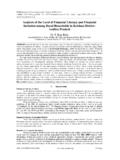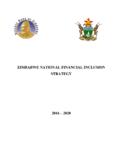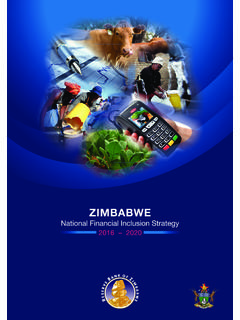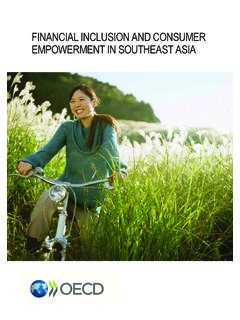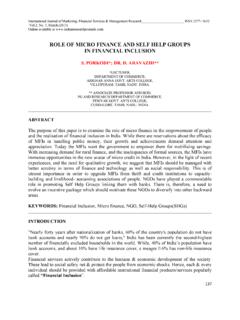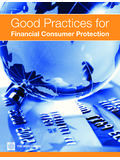Transcription of G20/OECD INFE
1 G20/OECD INFE CORE competencies FRAMEWORK ON financial literacy FOR ADULTS1 OECD/INFE INtErNatIONal SurvEy OF G20/OECD INFE COrE competencies FraMEWOrK ON financial literacy FOr aDultSAdult financial literacy competencies OECD/INFE International Survey of adult financial literacy competencies OECD 2016 This work is published under the responsibility of the Secretary-General of the OECD. The opinions expressed and arguments employed herein do not necessarily reflect the official views of OECD member countries. This document and any map included herein are without prejudice to the status of or sovereignty over any territory, to the delimitation of international frontiers and boundaries and to the name of any territory, city or area.
2 The statistical data for Israel are supplied by and under the responsibility of the relevant Israeli authorities. The use of such data by the OECD is without prejudice to the status of the Golan Heights, East Jerusalem and Israeli settlements in the West Bank under the terms of international law. OECD/INFE INTERNATIONAL SURVEY OF adult financial literacy competencies OECD 2016 3 Foreword financial education, financial consumer protection and financial inclusion are recognised at the highest policy level as three essential ingredients for the financial empowerment of individuals and the overall stability of the financial system, as highlighted through three sets of high-level principles endorsed by G20 leaders: Innovative financial Inclusion (2010); financial Consumer Protection (2011); and National Strategies for financial Education (2012).
3 As indicated in the High-level Principles on National Strategies, developed by the OECD International Network on financial Education (OECD/INFE), assessing the financial literacy competencies of the population is a key component of a successful national strategy. The opportunity to collect data using an internationally relevant instrument through a co-ordinated exercise further increases the value of such an assessment by enabling countries to benchmark themselves, identify common patterns and work together to find solutions for improving financial literacy and wellbeing within their respective populations.
4 With these benefits in mind, 30 countries and economies, drawn from Africa, Asia, Europe, Australasia, North America and South America, participated in an international survey of financial literacy competencies using the globally recognised OECD/INFE toolkit. This worldwide exercise is a key achievement for the OECD/INFE, which set the development of a method to measure and compare financial literacy as one of its three initial objectives. These first, high-level results provide information about financial literacy that go far beyond knowledge, covering aspects of financial behaviour, attitudes and inclusion.
5 As such, it provides the first opportunity for countries to see how the overall financial literacy of their adult populations compares with others. This unique analysis is also a first step towards further exploration into relevant areas to support effective financial empowerment policies such as differences in financial literacy by gender, age and social background, as well as financial well-being and consumer protection. In addition, following a call from G20 leaders in the 2016 Hangzhou Action Plan for a G20 report on financial literacy , a further report on financial literacy among G20 economies using the OECD/INFE tool will be prepared for release under the German G20 presidency in 2017.
6 4 OECD/INFE INTERNATIONAL SURVEY OF adult financial literacy competencies OECD 2016 ACKNOWLEDGEMENTS This publication represents an important component of the work of the OECD International Network on financial Education (OECD/INFE). It would not have been possible without the collaboration of the OECD/INFE countries and economies, and the external bodies listed in Annex 3, or the input of OECD/INFE members and participating countries who commented on three drafts of the report. The publication was prepared by Adele Atkinson with input from Chiara Monticone and oversight by Flore-Anne Messy in the financial Affairs Division of the OECD Directorate for financial and Enterprise Affairs.
7 The editing team included Jennah Huxley, Pamela Duffin, Pauline Arbel and Lynn Kirk. OECD/INFE INTERNATIONAL SURVEY OF adult financial literacy competencies OECD 2016 5 TABLE OF CONTENTS FOREWORD .. 3 EXECUTIVE 7 INTRODUCTION .. 15 I. financial KNOWLEDGE .. 19 II. financial BEHAVIOUR .. 33 III. financial ATTITUDES .. 47 IV. OVERALL LEVELS OF financial literacy .. 52 V. financial INCLUSION .. 54 VI. SELECTED POLICY CONCLUSIONS .. 59 REFERENCES .. 63 ANNEX 1: DATA TABLES .. 65 ANNEX 2: GUIDE TO CREATING THE financial literacy SCORES AND financial INCLUSION INDICATORS .. 85 ANNEX 3: SURVEY INFORMATION.
8 91 Tables Table 1. financial knowledge questions .. 20 Table 2. financial knowledge .. 23 Table 3. financial knowledge score by self-assessed knowledge .. 30 Table 4. Household financial decision making and 34 Table 5. Agrees with financial behaviour statements .. 37 Table 6. Questions on making ends meet .. 39 Table 7. Questions on choosing products .. 41 Table 8. financial attitude questions .. 48 Table 9. Principal Components Analysis of Attitude variables .. 50 Table 10. Number of respondents per country .. 65 Table 11. Distributions of financial knowledge scores .. 66 Table 12. Minimum target scores (5 or more) on financial knowledge.
9 67 Table 13. financial knowledge and goal setting .. 68 Table 14. financial knowledge and retirement planning .. 69 Table 15. Self-reported financial knowledge .. 70 Table 16. financial knowledge scores .. 71 Table 17. Minimum target score (5 or more) on financial knowledge by gender .. 72 Table 18. Active savers .. 73 6 OECD/INFE INTERNATIONAL SURVEY OF adult financial literacy competencies OECD 2016 Table 19. Principal components analysis: financial behaviour .. 74 Table 20. Making ends meet .. 74 Table 21. Choosing financial products .. 75 Table 22. Choosing financial products score .. 76 Table 23.
10 Distribution of financial behaviour scores .. 77 Table 24. Minimum target score (6 or more) on financial behaviour .. 78 Table 25. financial behaviour scores .. 79 Table 26. financial knowledge, attitudes and behaviour .. 80 Table 27. financial product holding .. 81 Table 28. Does not agree with short-term attitude statement .. 82 Table 29. Minimum target score (more than 3) on financial attitudes .. 83 Table 30. Indicators of financial inclusion .. 84 Table 31. Computing a financial knowledge score .. 86 Table 32. Computing a financial behaviour score .. 87 Table 33. Computing a financial attitudes score.










